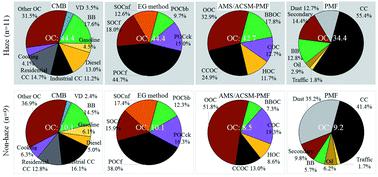当前位置:
X-MOL 学术
›
Faraday Discuss.
›
论文详情
Our official English website, www.x-mol.net, welcomes your feedback! (Note: you will need to create a separate account there.)
An evaluation of source apportionment of fine OC and PM2.5 by multiple methods: APHH-Beijing campaigns as a case study
Faraday Discussions ( IF 3.4 ) Pub Date : 2020-09-23 , DOI: 10.1039/d0fd00095g Jingsha Xu 1 , Deepchandra Srivastava , Xuefang Wu , Siqi Hou , Tuan V Vu , Di Liu , Yele Sun , Athanasia Vlachou , Vaios Moschos , Gary Salazar , Sönke Szidat , André S H Prévôt , Pingqing Fu , Roy M Harrison , Zongbo Shi
Faraday Discussions ( IF 3.4 ) Pub Date : 2020-09-23 , DOI: 10.1039/d0fd00095g Jingsha Xu 1 , Deepchandra Srivastava , Xuefang Wu , Siqi Hou , Tuan V Vu , Di Liu , Yele Sun , Athanasia Vlachou , Vaios Moschos , Gary Salazar , Sönke Szidat , André S H Prévôt , Pingqing Fu , Roy M Harrison , Zongbo Shi
Affiliation

|
This study aims to critically evaluate the source apportionment of fine particles by multiple receptor modelling approaches, including carbon mass balance modelling of filter-based radiocarbon (14C) data, Chemical Mass Balance (CMB) and Positive Matrix Factorization (PMF) analysis on filter-based chemical speciation data, and PMF analysis on Aerosol Mass Spectrometer (AMS-PMF) or Aerosol Chemical Speciation Monitor (ACSM-PMF) data. These data were collected as part of the APHH-Beijing (Atmospheric Pollution and Human Health in a Chinese Megacity) field observation campaigns from 10th November to 12th December in winter 2016 and from 22nd May to 24th June in summer 2017. 14C analysis revealed the predominant contribution of fossil fuel combustion to carbonaceous aerosols in winter compared with non-fossil fuel sources, which is supported by the results from other methods. An extended Gelencsér (EG) method incorporating 14C data, as well as the CMB and AMS/ACSM-PMF methods, generated a consistent source apportionment for fossil fuel related primary organic carbon. Coal combustion, traffic and biomass burning POC were comparable for CMB and AMS/ACSM-PMF. There are uncertainties in the EG method when estimating biomass burning and cooking OC. The POC from cooking estimated by different methods was poorly correlated, suggesting a large uncertainty when differentiating this source type. The PM2.5 source apportionment results varied between different methods. Through a comparison and correlation analysis of CMB, PMF and AMS/ACSM-PMF, the CMB method appears to give the most complete and representative source apportionment of Beijing aerosols. Based upon the CMB results, fine aerosols in Beijing were mainly secondary inorganic ion formation, secondary organic aerosol formation, primary coal combustion and from biomass burning emissions.
更新日期:2020-11-27



























 京公网安备 11010802027423号
京公网安备 11010802027423号